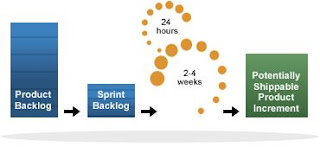Scrum Is an Innovative Approach to Getting Work Done
Scrum is an agile framework for completing complex projects. Scrum originally was formalized for software development projects, but works well for any complex, innovative scope of work. The possibilities are endless. The Scrum framework is deceptively simple.
The Scrum Framework in 30 Seconds
- A product owner creates a prioritized wish list called a product backlog.
- During sprint planning, the team pulls a small chunk from the top of that wishlist, a sprint backlog, and decides how to implement those pieces.
- The team has a certain amount of time, a sprint, to complete its work - usually two to four weeks - but meets each day to assess its progress (daily scrum).
- Along the way, the ScrumMaster keeps the team focused on its goal.
- At the end of the sprint, the work should be potentially shippable, as in ready to hand to a customer, put on a store shelf, or show to a stakeholder.
- The sprint ends with a sprint review and retrospective.
- As the next sprint begins, the team chooses another chunk of the product backlog and begins working again.

The cycle repeats until enough items in the product backlog have been completed, the budget is depleted, or a deadline arrives. Which of these milestones marks the end of the work is entirely specific to the project. No matter which impetus stops work, Scrum ensures that the most valuable work has been completed when the project ends.
A Few Detailed Definitions
Product backlog: A product backlog is dynamic—Items may be deleted or added at any time during the project. It is prioritized—Items with the highest priority are completed first. It is progressively refined—Lower priority items are intentionally coarse-grained.
Sprint backlog: A sprint backlog is a negotiated set of items from the product backlog that a team commits to complete during the timebox of a sprint. Items in the sprint backlog are broken into detailed tasks for the team members to complete. The team works collaboratively to complete the items in the sprint backlog, meeting each day (during a daily scrum) to share struggles and progress and update the sprint backlog and burndown chart accordingly.
Potentially Shippable: Potentially shippable means that the increment/deliverable could be released to a customer.The product owner makes the decision about when to actually release any functionality or deliverable.
- Product owner: responsible for the business value of the project
- ScrumMaster: ensures that the team is functional and productive
- Team: self-organizes to get the work done
- Sprint planning: the team meets with the product owner to choose a set of work to deliver during a sprint
- Daily scrum: the team meets each day to share struggles and progress
- Sprint reviews: the team demonstrates to the product owner what it has completed during the sprint
- Sprint retrospectives: the team looks for ways to improve the product and the process.
- Product backlog: prioritized list of desired project outcomes/features
- Sprint backlog: set of work from the product backlog that the team agrees to complete in a sprint, broken into tasks
- Burndown chart: at-a-glance look at the work remaining (can have two charts: one for the sprint and one for the overall project)
No comments:
Post a Comment